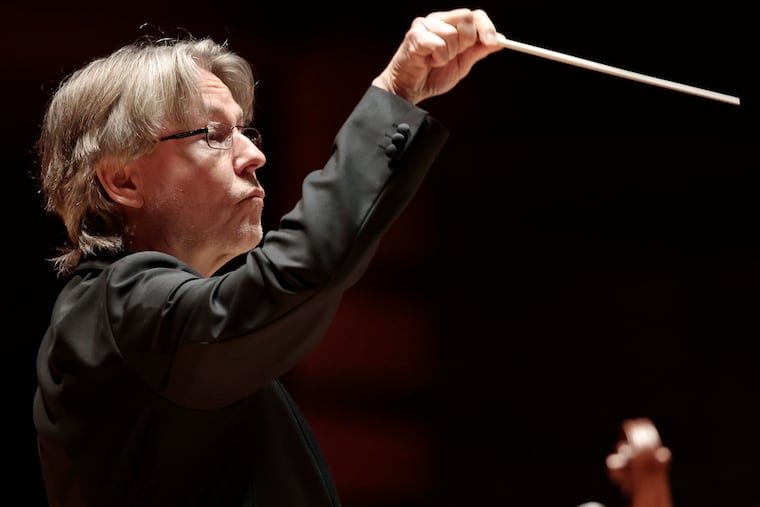Esa-Pekka Salonen does a rare Philadelphia Orchestra two-week conducting stint. Is it love?
The Finnish conductor's Philadelphia visit was artistically important. The orchestra should figure out how to make it happen more often.

There’s something special going on between the Philadelphia Orchestra and Esa-Pekka Salonen. The Finnish conductor has visited sporadically over the decades, but his concerts this weekend cap a two-week Verizon Hall residency so stunningly successful it makes you wonder whether there’s a formal relationship of some kind in the offing.
The high point was a Ravel Daphnis et Chloé heard Thursday night that simultaneously made the orchestra a collection of sharply individualized instrumental soloists and an impressively cohesive virtuoso instrument in itself. Salonen’s vision for the work even eclipsed Charles Dutoit’s, at least in the tightness of ensemble and pacing of drama. (For pure sensuality, Dutoit’s Daphnis still stands alone.)
Comparisons to Dutoit are useful to ponder in another way. Time was, this orchestra had close relationships with a number of top conductors (Simon Rattle, Vladimir Jurowski, Rafael Frühbeck de Burgos, as well as Dutoit), and often a conductor would come in for a multiple-week visit. This is rare now. But an extended residency allows for certain efficiencies in rehearsal and performance that spill over from one week to the next. Communication shorthand between players and the podium builds, and, if things go well, artistic momentum takes over.
I have no inside intelligence on how the orchestra and Salonen feel about each other, but if results speak truth, the connection is strong. To the audience, at least, Salonen is a talker; Thursday night he offered a long explanation on how the Ravel, Saariaho’s Lumière et Pesanteur, and his own Sinfonia concertante for organ and orchestra were related to each other. My sense is that as a conductor, Salonen is a talker in rehearsal, too.
But he has the goods in performance in the moment — that is, the technique. In both the Ravel and a volcanic Sibelius Symphony No. 5 last week, he was the wisest of leaders: He maintains absolute control over the ensemble; you viscerally sense the point of contact between what he’s doing with his hands and the resulting sound. And yet within those lines, musicians are playing with a sense of individuality and freedom. Mutual respect appears to travel both ways.
Salonen has long maintained a profile equal parts conductor and composer, and in addition to the piece for organ and orchestra — performed with great style and dash by Olivier Latry — he brought his Kínēma for clarinet and string orchestra last week. It handed Ricardo Morales an incredibly difficult role, and the orchestra’s principal clarinetist did not disappoint.
Both that piece and the one for organ are beautifully crafted. In his compositional work, Salonen has absorbed everything an orchestra can do. What’s missing is an element of pure inspiration, a musical imprint that sounds like no one else. Emotionally, Kínēma is oddly anodyne. Saariaho’s Lumière et Pesanteur is a singular visit into a strong personality and soundworld, as was Steven Stucky’s Radical Light, also performed last week. I can’t quite tell you who Salonen is as a composer.
On the podium, he is one of those conductors who makes it clear from the first note that he has a plan for how it connects to the very last. He had already amassed so much tension early on in the Sibelius’s Fifth, you wondered whether he could sustain it. And yet, the tension continued to build. When the climax of the first movement arrived, the entire preceding section felt in retrospect like a long runway into flight. He shaped the very end of the piece as a series of ebbs and flows — a hard-won struggle rather than a journey whose destination was guaranteed.
Climax was also one of the most arresting aspects of the Ravel. The feature is built into the piece itself, of course. But Salonen had a particularly lucid, and yet dramatic, approach. The opening sequence was astonishing. Rather than being gauzy or wallowing in sonic splendor, atmosphere was built through an exacting composition of instrumental balance, colors, and pacing. The piece uses wordless voices, and the Philadelphia Symphonic Choir was both nimble and full of personality. Soloists too numerous to mention contributed deep characterizations — hornist Jennifer Montone was heroic, violinist Juliette Kang poignant, Patrick Williams warm on alto flute.
But it really was the collective that underscored why Salonen is someone you want around more often. The ensemble sound was subtle and flexible, yet individual and at times incredibly powerful and warm. The 65-year-old conductor recently announced that he’s stepping down from the San Francisco Symphony’s podium after only a handful of years, so he may have the time. This Philadelphia visit was an artistically important two weeks. The orchestra should figure out what it means and how to make it happen more often.
Additional performances: Friday at 2 p.m. and Saturday at 8 p.m. in Verizon Hall, Broad and Spruce Sts. Tickets are $25-$129. philorch.org, 215-893-1999.